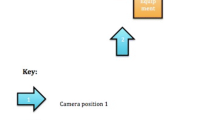Abstract
Background
Only a few reports on static strain in the spine, neck, and head of the surgeon are available, describing it as “distinctly harmful.” The aim of this study was to objectively prove the static burden during laparoscopic operations. For this, new industrial software called PCMAN was used, capable of measuring and comparing the postures of the surgeon at different monitor placements.
Methods
Two simultaneous and synchronized video recordings of laparoscopic cholecystectomies (LC) were done using miniDV digital camcorders with the cameras standing at a 90° angle to each other. Twenty operations were performed using two different placements of the monitor. In 10 cases, the monitor was placed at the patient’s head in the center, and in 10 cases at the left side of the patient. Using the time codes of the recordings, different steps of the operation were identified, and the duration of these measured in seconds. Very characteristic, longer lasting postures were imported to and analyzed with the software. Results of the different setups were compared to each other, and to an “ideal” comfort posture.
Results
During the intermediate steps of the operations the rate of static phases is significantly higher. Measuring the typical postures of these phases the trunk and head are significantly more rotated and bent than in comfort positions. When the monitor was at the side of the patient facing the surgeon, results were closer to the comfort posture.
Conclusions
It was proven that surgeons are confronted by significant static burden during LC. The software used was able to evaluate objectively the static posture of the surgeon during series of LC. Results also confirmed that the position of monitors significantly influences the surgeon’s posture. Best setups for the whole team can be achieved by adjustable multiple monitor systems.





Similar content being viewed by others
References
R Berguer GT Rab H Abu-Ghaida A Alarcon J Chung (1997) ArticleTitleA comparison of surgeons’ posture during laparoscopic and open surgical procedures. Surg Endosc 2 139–142 Occurrence Handle10.1007/s004649900316
R Berguer DL Forkey WD Smith (1999) ArticleTitleErgonomic problems associated with laparoscopic surgery. Surg Endosc 5 466–468
R Berguer WD Smith YH Chung (2001) ArticleTitlePerforming laparoscopic surgery is significantly more stressful for the surgeon than open surgery. Surg Endosc 10 1204–1207 Occurrence Handle10.1007/s004640080030
R Berquer WD Smith S Davis (2002) ArticleTitleAn ergonomic study of the optimum operating table height for laparoscopic surgery. Surg Endosc 3 416–421 Occurrence Handle10.1007/s00464-001-8190-y
A Cuschieri (1995) ArticleTitleWhither minimal access surgery: tribulations and expectations. Am J Surg 1 9–19
TA Emam TG Frank GB Hanna A Cuschieri (2001) ArticleTitleInfluence of handle design on the surgeon’s upper limb movements, muscle recruitment, and fatigue during endoscopic suturing. Surg Endosc 7 667–672 Occurrence Handle10.1007/s004640080141
GB Hanna SM Shimi A Cuschieri (1998) ArticleTitleTask performance in endoscopic surgery is influenced by location of the image display. Ann Surg 4 481–484 Occurrence Handle10.1097/00000658-199804000-00005
LF Horgan DC O’Rionda N Doctor (1997) ArticleTitleNeoropraxia following laparoscopic procedures: an occupational injury. Min Inv Ther Allied Technol 6 33–35
NT Nguyen HS Ho WD Smith C Philipps C Lewis RM Vera ParticleDe R Berguer (2001) ArticleTitleAn ergonomic evaluation of surgeons’ axial skeletal and upper extremity movements during laparoscopic and open surgery. Am J Surg 6 720–724 Occurrence Handle10.1016/S0002-9610(01)00801-7
JG Person AJ Hodgson AG Nagy (2001) ArticleTitleAutomated high-frequency posture sampling for ergonomic assessment of laparoscopic surgery. Surg Endosc 9 997–1003
T Seitz J Balzulat H Bubb (2000) ArticleTitleAnthropometry and measurement of posture and motion. Int J Indust Ergonomics 25 447–453 Occurrence Handle10.1016/S0169-8141(99)00028-1
MA Veelen Particlevan JJ Jakimowicz RHM Goossens DW Meijer JBJ Bussmann (2002) ArticleTitleEvaluation of the usability of two types of image display systems during laparoscopy. Surg Endosc 16 674–678 Occurrence Handle10.1007/s00464-001-9116-4 Occurrence Handle1:STN:280:DC%2BD383jsVequg%3D%3D Occurrence Handle11972213
Author information
Authors and Affiliations
Corresponding author
Rights and permissions
About this article
Cite this article
Vereczkei, A., Feussner, H., Negele, T. et al. Ergonomic assessment of the static stress confronted by surgeons during laparoscopic cholecystectomy. Surg Endosc 18, 1118–1122 (2004). https://doi.org/10.1007/s00464-003-9157-y
Received:
Accepted:
Published:
Issue Date:
DOI: https://doi.org/10.1007/s00464-003-9157-y




